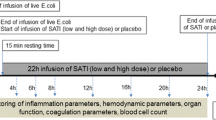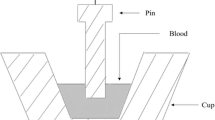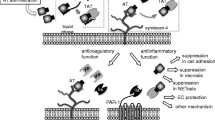Abstract
Activated thrombin-activatable fibrinolysis inhibitor (TAFIa or CPU) is a carboxypeptidase that is able to attenuate fibrinolysis. Although its role in fibrinolysis and inflammation has been studied extensively in vitro, its levels and subsequent effect in vivo has not been studied to the same extent. Using our recently developed assay that is specific for TAFIa, we were able to quantify its levels in plasma samples obtained from an Escherichia coli (E. coli) challenged baboon sepsis model. TAFIa levels accumulated appeared to be E. coli dose dependent, where the lethal dose of 1010 CFU/kg generated a peak TAFIa level of 24 nM by 2 h, which represents almost 32% of total plasma level of its precursor, thrombin-activatable fibrinolysis inhibitor (TAFI or proCPU). Furthermore, our data suggest that there is continual TAFI activation under lethal level of E. coli as the apparent half-life of TAFIa is increased from 8 min to 2.2 h. Two sublethal doses of 108 and 106 CFU/kg generated peak TAFIa levels of 1.1 and 0.4 nM, respectively, both by 6 h. Taken together, our data show that TAFIa is generated at systemic levels, in a dose-dependent manner, that can substantially affect both fibrinolysis and inflammatory response in the E. coli challenged baboon sepsis model.

Similar content being viewed by others
Abbreviations
- IIa:
-
Thrombin
- IIa–TM:
-
Thrombin/thrombomodulin complex
- TAFI(a):
-
Thrombin-activatable fibrinolysis inhibitor (activated)
- Pg:
-
Plasminogen
- FN′:
-
Plasmin-modified fibrin
- t-PA:
-
Tissue-type plasminogen activator
- APC/PCI:
-
Activated protein C-protein C inhibitor complex
- E. coli :
-
Escherichia coli
- SLEC:
-
Sublethal E. coli
- LDEC:
-
Lethal E. coli
- HBS:
-
0.02 M HEPES, 0.15 M NaCl, pH 7.4
- 5IAF-Pg:
-
Recombinant Pg with a single mutation of the active site serine to a cysteine (S741C) labelled with 5-iodoacetamidofluorescein (5IAF)
- QSY-FDPs:
-
QSY9 C5 maleimide-labelled fibrin degradation products
- TDP:
-
TAFI-deficient plasma
References
Nesheim M, Wang W, Boffa M, Nagashima M, Morser J, Bajzar L (1997) Thrombin, thrombomodulin and TAFI in the molecular link between coagulation and fibrinolysis. Thromb Haemost 78:386–391
Bouma BN, Marx PF, Mosnier LO, Meijers JCM (2001) Thrombin-activatable fibrinolysis inhibitor (TAFI, plasma procarboxypeptidase B, procarboxypeptidase R, procarboxypeptidase U). Thromb Res 101(5):329–354
Willemse JL, Hendriks DF (2007) A role for procarboxypepidase U (TAFI) in thrombosis. Front Biosci 12:1973–1987
Bajzar L (2000) Thrombin activatable fibrinolysis inhibitor and an antifibrinolytic pathway. Arterioscler Thromb Vasc Biol 20(12):2511–2518
Bajzar L, Morser J, Nesheim M (1996) TAFI, or plasma procarboxypeptidase B, couples the coagulation and fibrinolytic cascades through the thrombin-thrombomodulin complex. J Biol Chem 271:16603–16608
Heylen E, Van Goethem S, Augustyns K, Hendriks D (2010) Measurement of carboxypeptidase U (active thrombin-activatable fibrinolysis inhibitor) in plasma: challenges overcome by a novel selective assay. Anal Biochem 403(1–2):114–116
Willemse JL, Hendriks DF (2006) Measurement of procarboxypeptidase U (TAFI) in human plasma: a laboratory challenge. Clin Chem 52(1):30–36
Kim PY, Foley J, Hsu G, Kim PY, Nesheim ME (2008) An assay for measuring functional activated thrombin-activatable fibrinolysis inhibitor in plasma. Anal Biochem 372(1):32–40
Heylen E, Van Goethem S, Willemse J, Olsson T, Augustyns K, Hendriks D (2010) Development of a sensitive and selective assay for the determination of procarboxypeptidase U (thrombin-activatable fibrinolysis inhibitor) in plasma. Anal Biochem 396(1):152–154
Willemse JL, Brouns R, Heylen E, De Deyn PP, Hendriks DF (2008) Carboxypeptidase U (TAFIa) activity is induced in vivo in ischemic stroke patients receiving thrombolytic therapy. J Thromb Haemost 6(1):200–202
Kim PY, Kim PY, Hoogendorn H, Giles AR, Nesheim ME (2008) Activated thrombin-activatable fibrinolysis inhibitor is generated in vivo at levels that can substantially affect fibrinolysis in chimpanzees in response to thrombin generation. J Thromb Haemost 6(9):1600–1602
Taylor FB, Chang A, Esmon CT, D’Angelo A, Vigano-D’Angelo S, Blick KE (1987) Protein C prevents the coagulopathic and lethal effects of Escherichia coli infusion in the baboon. J Clin Invest 79:918–925
Taylor FB Jr (2001) Staging of the pathophysiologic responses of the primate microvasculature to Escherichia coli and endotoxin: examination of the elements of the compensated response and their links to the corresponding uncompensated lethal variants. Crit Care Med 29(7 Suppl):S78–S89
Binette TM, Taylor FB Jr, Peer G, Bajzar L (2007) Thrombin-thrombomodulin connects coagulation and fibrinolysis: more than an in vitro phenomenon. Blood 110(9):3168–3175
Boffa MB, Wang W, Bajzar L, Nesheim ME (1998) Plasma and recombinant thrombin-activable fibrinolysis inhibitor (TAFI) and activated TAFI compared with respect to glycosylation, thrombin/thrombomodulin-dependent activation, thermal stability, and enzymatic properties. J Biol Chem 273(4):2127–2135
Schneider M, Boffa M, Stewart R, Rahman M, Koschinsky M, Nesheim M (2002) Two naturally occurring variants of TAFI (Thr-325 and Il-325) differ substantially with respect to thermal stability and antifibrinolytic activity of the enzyme. J Biol Chem 277(2):1021–1030
Bajzar L, Jain N, Wang P, Walker JB (2004) Thrombin activatable fibrinolysis inhibitor: not just an inhibitor of fibrinolysis. Crit Care Med 32(5 Suppl):S320–S324
Song JJ, Hwang I, Cho KH, Garcia MA, Kim AJ, Wang TH, Lindstrom TM, Lee AT, Nishimura T, Zhao L, Morser J, Nesheim M, Goodman SB, Lee DM, Bridges SL Jr, Gregersen PK, Leung LL, Robinson WH (2011) Plasma carboxypeptidase B downregulates inflammatory responses in autoimmune arthritis. J Clin Invest 121(9):3517–3527
Zeerleder S, Schroeder V, Hack E, Kohler HP, Wuillemin WA (2006) TAFI and PAI-1 levels in human sepsis. Thromb Res 118(2):205–212
Acknowledgments
This work was supported by the Heart and Stroke Foundation of Ontario (T5575) and the National Institutes of Health (P01 HL2046703) (to MEN), the Canadian Institutes of Health Research Fellowship (to PYK), and the Queen’s University Graduate Fellowship (to PYGK).
Author information
Authors and Affiliations
Corresponding author
Rights and permissions
About this article
Cite this article
Kim, P.Y., Kim, P.Y.G., Taylor, F.B. et al. Thrombin-activatable fibrinolysis inhibitor is activated in vivo in a baboon model of Escherichia coli induced sepsis. J Thromb Thrombolysis 33, 412–415 (2012). https://doi.org/10.1007/s11239-011-0676-4
Published:
Issue Date:
DOI: https://doi.org/10.1007/s11239-011-0676-4




